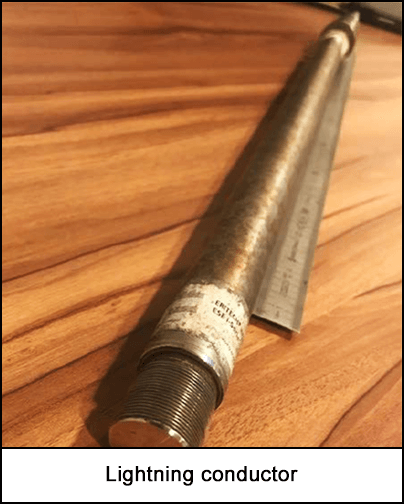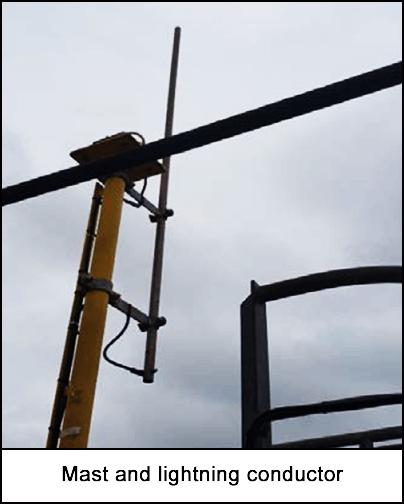-
What happened?
A vessel was in dry dock.
A lightning conductor mounted on top of the vessel’s service crane came free from its mounting.
The conductor dropped 75m (245ft) and fell through the deck carousel hatch, landing on the bottom plate.
There were no injuries as the five crew members that were working in the carousel were not under the open deck hatch area.

-
Why did it happen?
Mast has been vibrating during high winds, causing the lightning conductor to work itself free from the threaded housing.
Lightning conductor was only secured to its housing by a threaded connection – there was no secondary securing.
The risk of the lightening conductor becoming unscrewed was not recognised.
The equipment was not part of planned maintenance system.
The connection was not easily visible during regular inspections.

-
What did they learn?
Inspect equipment mounted at height to ensure secondary securing is in place.
Conduct thorough inspections to recognise the risk of dropped objects. Ensure all items are evaluated, including those that are not easily visible.

-
Ask yourself or your crew
Has anything like this happened on your vessel/worksite? What did you do?
What equipment placed at height do we have on our worksite/vessel? How often is it inspected?
How can you check that all items with drops potential have been included in the risk assessment?
What measures do we have onsite to minimise the risk of dropped objects? What else should we do?

Add to homescreen
Content name
Select existing category:
Content name
New collection
Edit collection
What happened?
A vessel was in dry dock.
A lightning conductor mounted on top of the vessel’s service crane came free from its mounting.
The conductor dropped 75m (245ft) and fell through the deck carousel hatch, landing on the bottom plate.
There were no injuries as the five crew members that were working in the carousel were not under the open deck hatch area.

Why did it happen?
Mast has been vibrating during high winds, causing the lightning conductor to work itself free from the threaded housing.
Lightning conductor was only secured to its housing by a threaded connection – there was no secondary securing.
The risk of the lightening conductor becoming unscrewed was not recognised.
The equipment was not part of planned maintenance system.
The connection was not easily visible during regular inspections.

What did they learn?
Inspect equipment mounted at height to ensure secondary securing is in place.
Conduct thorough inspections to recognise the risk of dropped objects. Ensure all items are evaluated, including those that are not easily visible.
Ask yourself or your crew
Has anything like this happened on your vessel/worksite? What did you do?
What equipment placed at height do we have on our worksite/vessel? How often is it inspected?
How can you check that all items with drops potential have been included in the risk assessment?
What measures do we have onsite to minimise the risk of dropped objects? What else should we do?
A lightning conductor mounted on top of a service crane came free. It dropped 75m (245ft), falling through the deck carousel hatch and landing on the carousel bottom plate.














